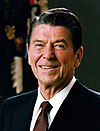Related Research Articles

The State of the Union Address is an annual message delivered by the president of the United States to a joint session of the United States Congress near the beginning of most calendar years on the current condition of the nation. The State of the Union Address generally includes reports on the nation's budget, economy, news, agenda, progress, achievements and the president's priorities and legislative proposals.

The 1999 State of the Union Address was given by the 42nd president of the United States, Bill Clinton, on January 19, 1999, at 9:00 p.m. EST, in the chamber of the United States House of Representatives to the 106th United States Congress. It was Clinton's sixth State of the Union Address and his seventh speech to a joint session of the United States Congress. Presiding over this joint session was the House speaker, Dennis Hastert, accompanied by Al Gore, the vice president, in his capacity as the president of the Senate.
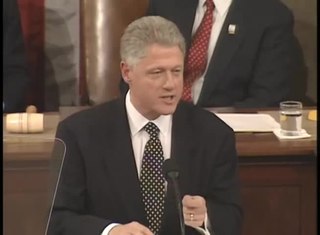
The 1998 State of the Union Address was given by the 42nd president of the United States, Bill Clinton, on January 27, 1998, at 9:00 p.m. EST, in the chamber of the United States House of Representatives to the 105th United States Congress. It was Clinton's fifth State of the Union Address and his sixth speech to a joint session of the United States Congress. Presiding over this joint session was the House speaker, Newt Gingrich, accompanied by Al Gore, the vice president, in his capacity as the president of the Senate.

The 1975 State of the Union address was given by President Gerald Ford to a joint session of the 94th United States Congress on January 15, 1975. The speech was the first State of the Union address of President Ford's tenure as president.

The 1988 State of the Union Address was given by the 40th president of the United States, Ronald Reagan, on January 25, 1988, at 9:00 p.m. EST, in the chamber of the United States House of Representatives to the 100th United States Congress. It was Reagan's seventh and final State of the Union Address and his eighth and final speech to a joint session of the United States Congress. Presiding over this joint session was the House speaker, Jim Wright, accompanied by George H. W. Bush, the vice president.

The 1985 State of the Union Address was given by the 40th president of the United States, Ronald Reagan, on February 6, 1985 — Reagan’s 74th birthday — at 9:00 p.m. EST, in the chamber of the United States House of Representatives to the 99th United States Congress. It was Reagan's fourth State of the Union Address and his fifth speech to a joint session of the United States Congress. Presiding over this joint session was the House speaker, Tip O'Neill, accompanied by George H. W. Bush, the vice president.
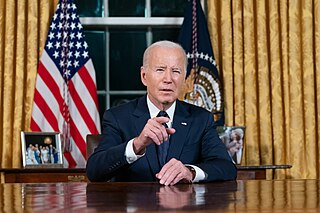
An Oval Office address is a type of speech made by the president of the United States, usually in the Oval Office at the White House. It is considered among the most solemn settings for an address made by a leader, and is most often delivered to announce a major new policy initiative, on the occasion of a leader's departure from office, or during times of national emergency.
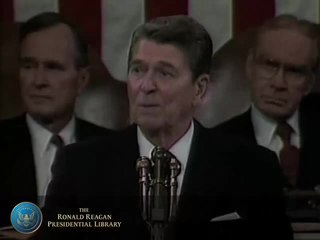
The 1987 State of the Union Address was given by the 40th president of the United States, Ronald Reagan, on January 27, 1987, at 9:00 p.m. EST, in the chamber of the United States House of Representatives to the 100th United States Congress. It was Reagan's sixth State of the Union Address and his seventh speech to a joint session of the United States Congress. Presiding over this joint session was the House speaker, Jim Wright, accompanied by George H. W. Bush, the vice president.

The 1984 State of the Union Address was given by the 40th president of the United States, Ronald Reagan, on January 25, 1984, at 9:00 p.m. EST, in the chamber of the United States House of Representatives to the 98th United States Congress. It was Reagan's third State of the Union Address and his fourth speech to a joint session of the United States Congress. Presiding over this joint session was the House speaker, Tip O'Neill, accompanied by George H. W. Bush, the vice president.

The 1982 State of the Union Address was given by the 40th president of the United States, Ronald Reagan, on January 26, 1982, at 9:00 p.m. EST, in the chamber of the United States House of Representatives to the 97th United States Congress. It was Reagan's first State of the Union Address and his second speech to a joint session of the United States Congress. Presiding over this joint session was the House speaker, Tip O'Neill, accompanied by George H. W. Bush, the vice president.

The 1983 State of the Union Address was given by the 40th president of the United States, Ronald Reagan, on January 25, 1983, at 9:00 p.m. EST, in the chamber of the United States House of Representatives to the 98th United States Congress. It was Reagan's second State of the Union Address and his third speech to a joint session of the United States Congress. Presiding over this joint session was the House speaker, Tip O'Neill, accompanied by George H. W. Bush, the vice president.
The 1991 State of the Union Address was given by the 41st president of the United States, George H. W. Bush, on January 29, 1991, at 9:00 p.m. EST, in the chamber of the United States House of Representatives to the 102nd United States Congress. It was Bush's second State of the Union Address and his third speech to a joint session of the United States Congress. Presiding over this joint session was the House speaker, Tom Foley, accompanied by Dan Quayle, the vice president, in his capacity as the president of the Senate.

The 1990 State of the Union Address was given by the 41st president of the United States, George H. W. Bush, on January 31, 1990, at 9:00 p.m. EST, in the chamber of the United States House of Representatives to the 101st United States Congress. It was Bush's first State of the Union Address and his second speech to a joint session of the United States Congress. Presiding over this joint session was the House speaker, Tom Foley, accompanied by Dan Quayle, the vice president, in his capacity as the president of the Senate.
The 1980 State of the Union address was given by President Jimmy Carter, the 39th president of the United States, to a joint session of the 96th United States Congress on January 23, 1980. Carter addressed the Iran Hostage Crisis and the Soviet invasion of Afghanistan: "At this time in Iran, 50 Americans are still held captive, innocent victims of terrorism and anarchy. Also at this moment, massive Soviet troops are attempting to subjugate the fiercely independent and deeply religious people of Afghanistan."
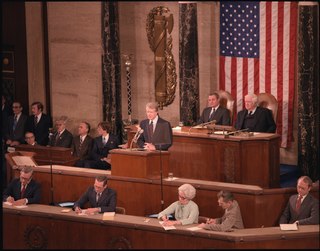
The 1979 State of the Union address was given by President Jimmy Carter to a joint session of the 96th United States Congress on January 23, 1979.
The 1978 State of the Union address was given by President Jimmy Carter to a joint session of the 95th United States Congress on January 19, 1978.

The 1976 State of the Union address was given by President Gerald R. Ford to a joint session of the 94th United States Congress on Monday, January 19, 1976.

Bill Clinton, the 42nd president of the United States, addressed a joint session of the United States Congress on Wednesday, February 17, 1993. It was his first public address before a joint session. Similar to a State of the Union Address, it was delivered before the 103rd United States Congress in the Chamber of the United States House of Representatives in the United States Capitol. Presiding over this joint session was the Speaker of the United States House of Representatives, Tom Foley, accompanied by Al Gore, the vice president in his capacity as the president of the Senate.
George H. W. Bush, the 41st president of the United States, addressed a joint session of the United States Congress on Wednesday, February 9, 1989. It was his first public address before a joint session. Similar to a State of the Union Address, it was delivered before the 101st United States Congress in the Chamber of the United States House of Representatives in the United States Capitol. Presiding over this joint session was the Speaker of the United States House of Representatives, Jim Wright, accompanied by Dan Quayle, the vice president in his capacity as the president of the Senate.

Ronald Reagan, the 40th president of the United States, addressed a joint session of the United States Congress on Wednesday, February 18, 1981. It was his first public address before a joint session. Similar to a State of the Union Address, it was delivered before the 97th United States Congress in the Chamber of the United States House of Representatives in the United States Capitol. Presiding over this joint session was the Speaker of the United States House of Representatives, Tip O'Neill, accompanied by George H. W. Bush, the vice president in his capacity as the president of the Senate.
References
- ↑ Reagan, Ronald (February 4, 1986). "Address Before a Joint Session of Congress on the State of the Union - 1986". Ronald Reagan Presidential Library & Museum. Retrieved July 19, 2021.
- ↑ "State of the Union Address: Ronald Reagan, February 4, 1986" . Retrieved April 28, 2018.
- ↑ "Length of State of the Union Addresses in Minutes". Presidency.ucsb.edu. Retrieved 2012-10-22.
- ↑ "Length of State of the Union Addresses". Presidency.ucsb.edu. Retrieved 2012-10-22.
- ↑ Weinraub, Bernard (January 29, 1986). "The Shuttle Explosion: Reagan Postpones State of the Union Speech". New York Times. p. A9.
- ↑ "Address to the nation on the Challenger disaster". Ronald Reagan Presidential Library. Archived from the original on February 19, 2012. Retrieved July 4, 2006.
- ↑ "Explosion of the Space Shuttle Challenger Address to the Nation, January 28, 1986" . Retrieved April 28, 2018.
- ↑ "President Reagan's 1986 State of the Union Address" . Retrieved April 29, 2018.
- ↑ "List of Opposition Responses to State of the Union Addresses". Presidency.ucsb.edu. Retrieved 2012-10-22.
- ↑ "List and Transcripts of Opposition Party Responses to State of the Union Addresses" . Retrieved April 28, 2018.
